‘Super Mario Bros. Wonder’ is Nintendo on Acid
- Oops!Something went wrong.Please try again later.
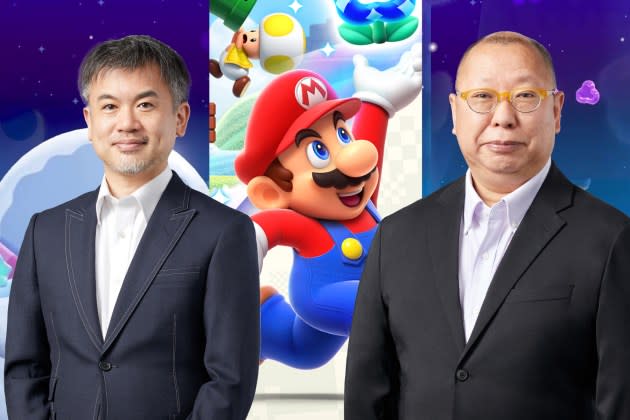
The Super Mario Bros. are everywhere these days. With international theme parks, a billion-dollar movie, and toys and Lego flooding the shelves of every store, the boys from Brooklyn are really getting around. With that ubiquity, it’s hard to believe that there hasn’t been a new 2D, “traditional” Mario game in over 10 years with the release of New Super Mario Bros. Wii U.
And while there’s been waves of 3D adventures, parties, karting, and every kind of sport outing, it’s fitting that now — at the height of its popularity — the series returns to its roots. Except, this isn’t a traditional Mario game.
More from Rolling Stone
‘The Legend of Zelda: Tears of the Kingdom’ Is a Perfect Video Game
Original ‘Mario’ Creator and Composer Unlock ‘The Super Mario Bros. Movie’
‘The Super Mario Bros. Movie’ Is Not Ruined by Chris Pratt’s Mario
This Mario is tripping balls.
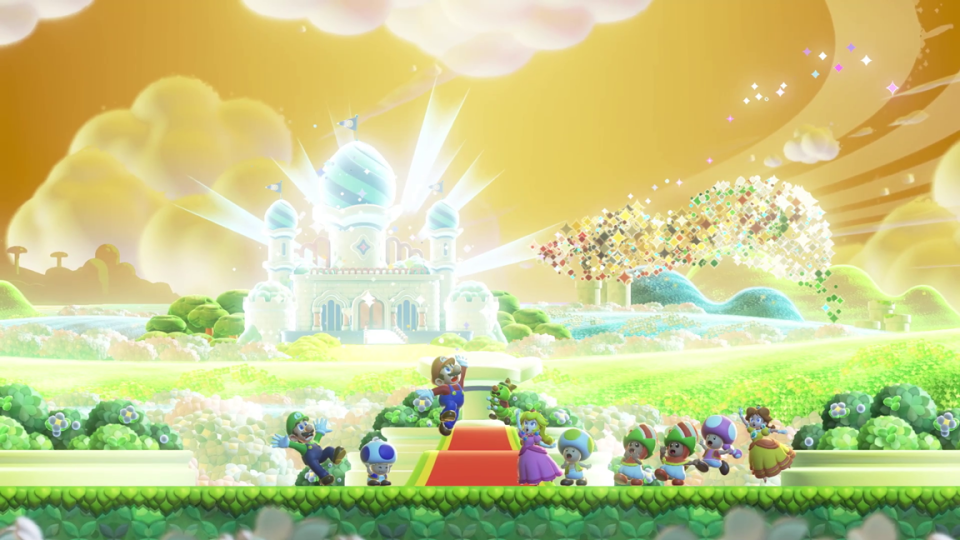
Rolling Stone recently had a chance to go hands-on with the game at a press event in New York, as well as sit down with the game’s director, Shiro Mouri, and producer, Takashi Tezuka. Through translation, they broke down their philosophy behind the biggest Mario redesign in years.
Secrets and Mysteries
The first thing you’ll notice when booting up Super Mario Bros. Wonder is that it’s visually arresting. Although it’s still a side scrolling platformer, it feels like a magnificent leap over the design of the New Super Mario Bros. series that has been the standard 2D Mario experience since 2006. In those games, Mario himself is an obvious 3D polygon positioned on a flat, 2D plane. The backgrounds have some detail, but even with its later iteration, there was a stock feeling to the game. It’s Mario, no frills.
Wonder quickly abates that with vibrancy. The character models — Mario, Luigi, Peach, Daisy, everyone — have all been given a face lift. By flattening and stretching the models to provide a more dioramic view of their bodies, they more resemble the pixelated sprites of the Super Mario World era. Those games had characters built proportionally in ways we shouldn’t be able to view them, but it allowed us to always see Mario’s face and front, and going back to that here allows for tons of emotive reaction and depth.
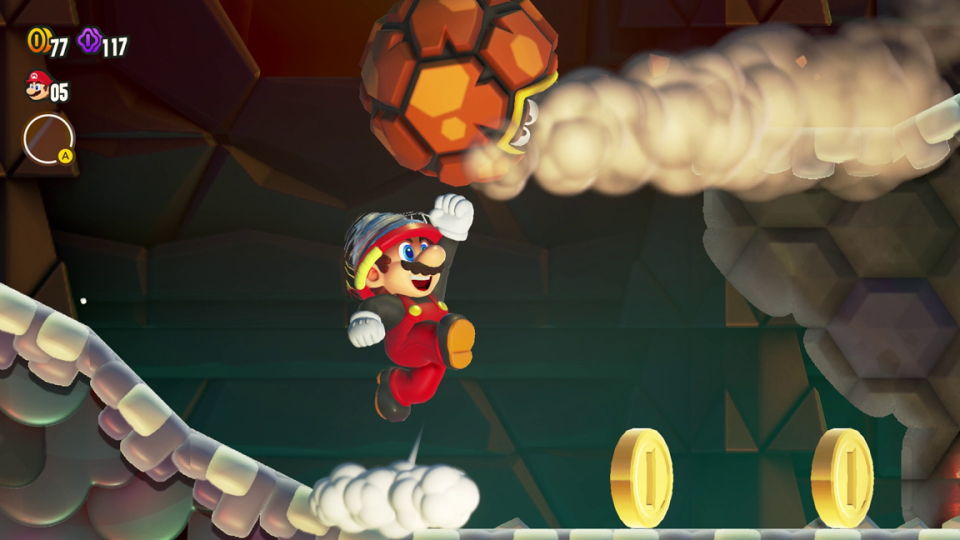
Tezuka himself acknowledges this, saying, “If you took what we created here and look at it from a 360 view around it, circle around it, you can see that it looks a little bit twisted and out of shape. But if we discovered that if he’s slightly tilted, it looks more appealing.”
That perspective allows characters to react to the gameplay and environment in surprising ways. Tilt up, Mario’s head goes up, mouth agape. Sprint into a pipe, and Mario’s cap gets left behind cuing an Indiana Jones-like reach and pluck. Even the individual characters (more on that later), each have bespoke animations that illustrate their personalities (for example: Mario throws fireballs hastily with two hands like a Dragon Ball Z fighter). Even the enemies have these reaction, as seen in the demo when they see an elephant-powered character approaching them, running for their lives, eyes averted back in fear. They even put eyelashes on the goombas.
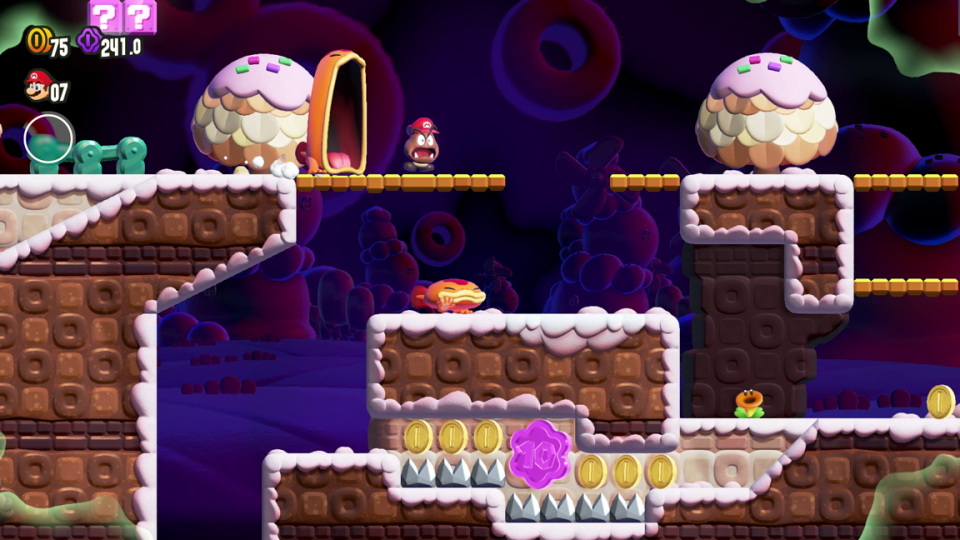
The impetus for much of this are what the developers refer to as “wonder elements,” which include not just the new power-ups (elephant, drill, and bubble) but new items called Wonder Flowers, which are unique to each level. This is where the game gets trippy as, upon touching one, the entire world shifts and contorts in psychedelia, pipes coming to life and the sky raining infinity stars. You never know how your initial interaction with a flower will suddenly change the tempo or gameplay, and that’s the goal.
Mouri says, “There’s the kind of traditional understanding of where you travel down a pipe, and that leads you to a secret underground area, you climb up a vine, it takes you to a secret sky area, we wanted to create like a new version of that. [And] that’s where we came up with idea of like pipes coming to life and wiggling around or the entire screen tilting to one way or even having to travel across a horde of enemies.
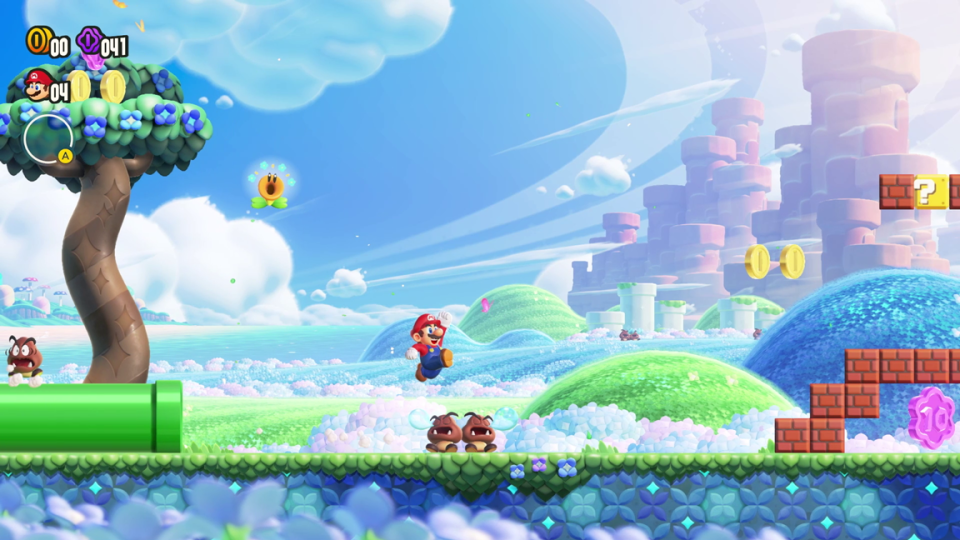
With an ethos of “secrets and mysteries,” the developers worked hard to ensure that the game remained consistently unpredictable. Although they deny any direct inspiration, it’s hard not to see a correlation between Wonder and Alice in Wonderland, with Mario and his creators peering through the looking glass.
Freedom of Choice
Another part of their ethos from the beginning of development (some time around 2019 after the release of Wii U Deluxe) was “freedom of choice.” And while this applies to the players, it began as an internal mentality. As explained by Tezuka, many of the new ideas and tones on display in Wonder are the result new generation of Mario developers having more freedom to deviate from the norm.
He says, “We really wanted to give the designers more freedom than we would have in the past. And more so than having a lot of people who’ve been making Mario games and working on Mario games for a long time, we had a lot of people who are new to the franchise. [I] said to them, ‘I’m really grateful that you being protective of Mario, but I really want you to think about what Mario needs to be now. What do think Mario needs to be in order to play it the way you want to play Mario.’”
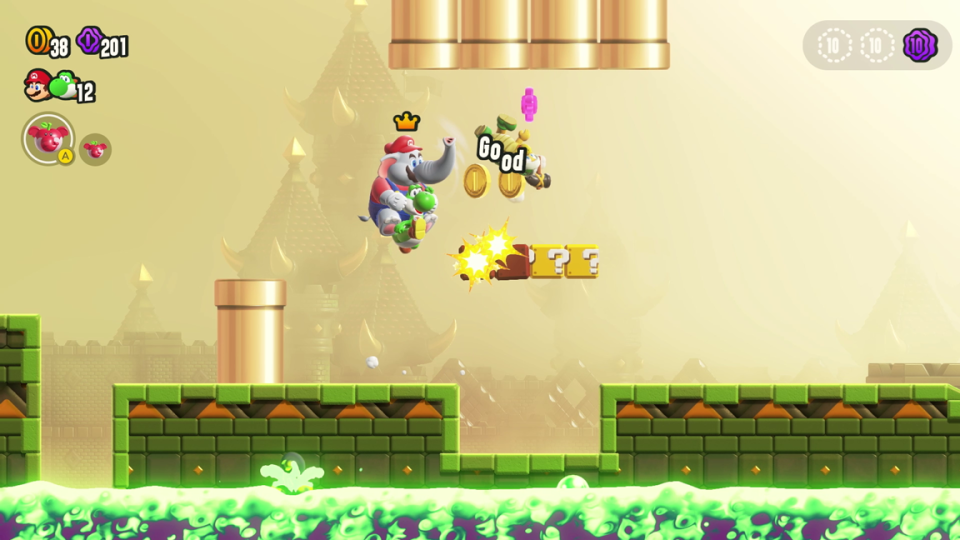
In gameplay, freedom of choice is conveyed in numerous ways. The first, and most obvious, is that players can now begin the game as not just Mario, but Luigi, Peach, Daisy (finally!), Toad, or Toadette, as well as multiple colors of Yoshi and Nabbit. The latter two are more viable options for younger or less experienced players, as they cannot take any damage but also open up new opportunities for collaborative play (think Mario riding Yoshi).
On the introduction of Daisy as a playable character in the mainline series, producer Shiro Mouri says, “I have two daughters and whenever it comes time to select characters, there was always a fight between who gets to control Peach. They really got into a fight. And so with the introduction of Daisy, I’m hoping that this will allow for a more peaceful household.”
But unlike games like the North American version of Super Mario Bros. 2, each character plays the same without unique traits. That’s left to the player with the introduction of the badge system. Badges are equippable abilities that players can unlock over time using an in-game currency called flower points, collected throughout every level. Some badges provide active abilities, like the ability to float gently after jumping (Peach’s trait from previous games) or the ability to wall jump more effectively like Mega Man. Others provide passive abilities like increasing the number of coins gathered through the level. Through this, players can choose the type of experience that best suits them, but of course there are unique challenges centered around each.
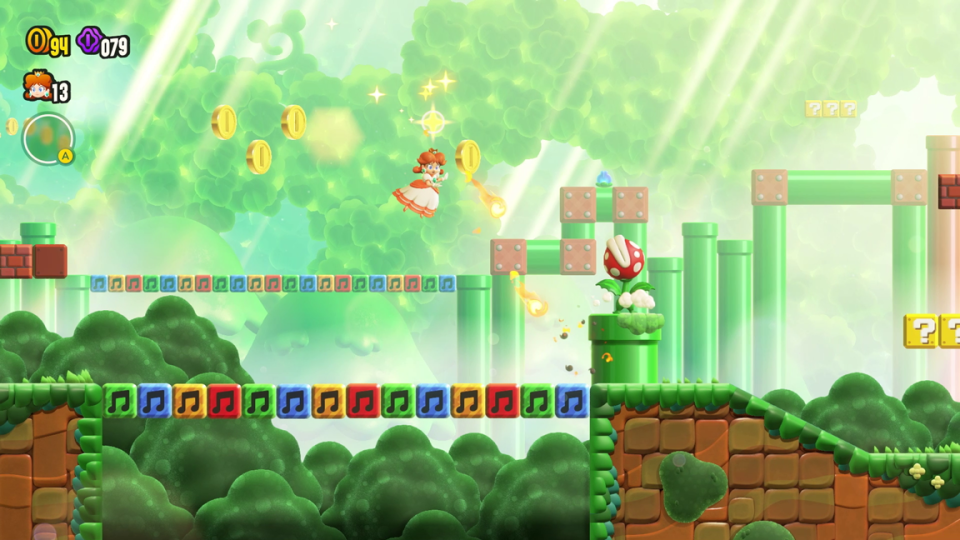
And while past 2D Mario games have always had some element of exploration with hidden warp pipes and hard-to-spot collectibles, Wonder emphasizes the discovery aspect further by removing the timer from most levels, allowing free rein to explore and experiment in the environment without the stress of racing against the clock.
Casual Connection
As exemplified by the increased freedom, one goal for Mouri and the team in designing the game was creating a “stress free” experience. That doesn’t mean the game is without difficulty; in our time playing levels were graded one to three stars in difficulty, and the harder ones required the intense focus and learned skill that all the best Mario games do.
Here, the freedom of stress means the freedom of stress from other people. Anyone who has played New Super Mario Bros Wii U Deluxe with friends knows that the gameplay is less cooperative than it is a frustrating race to screw or be screwed, where every simple leap could mean instant death as your buddy stomps you midair.
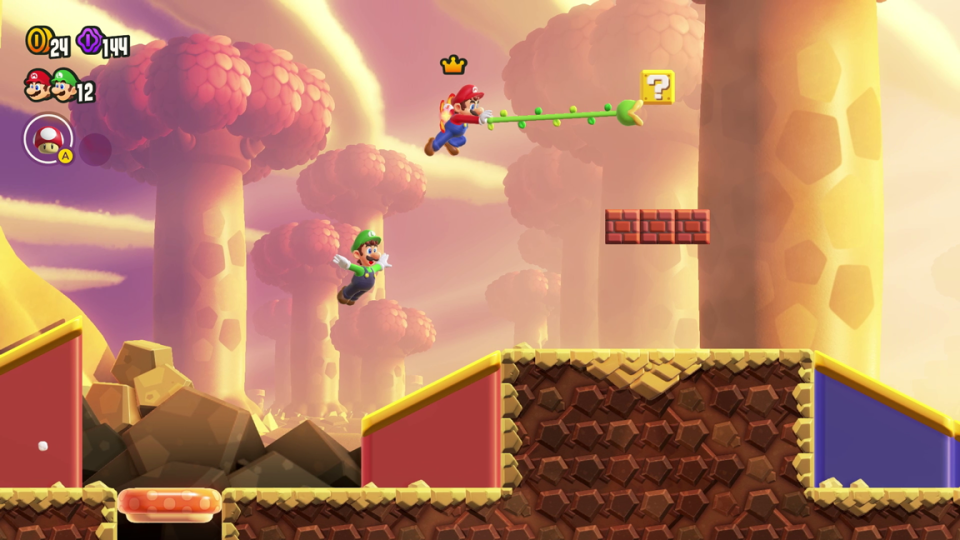
The secret here is simple: removing player collision. By allowing players to move freely through the course without bumping into one another, it feels more like you’re playing the game itself and not playing against everyone else.
Mouri explains that collision was initially part of the game but that changed during development, stating “When we took the leap of faith and removed collision, we realized that it removes a lot of the stress. For example, when you have a narrow platform that you to jump to, when somebody is there they just get in the way.”
Other pieces of gameplay help contribute to the cooperative play in ways that move the series forward. Previously, when a player died, they came back in a bubble requiring someone to bring them back into play at the cost of a life. Here, players become specters — ghosts of themselves and must manually race back to touch another player to be tagged in without using a life. It creates its own frantic dynamic, but this element affords players the opportunity to stay in the game longer. Imagine if the sole survivor of a level is playing a Yoshi, unable to take damage. Their ability to be a lightning rod for resurrection can help a group of stragglers along.
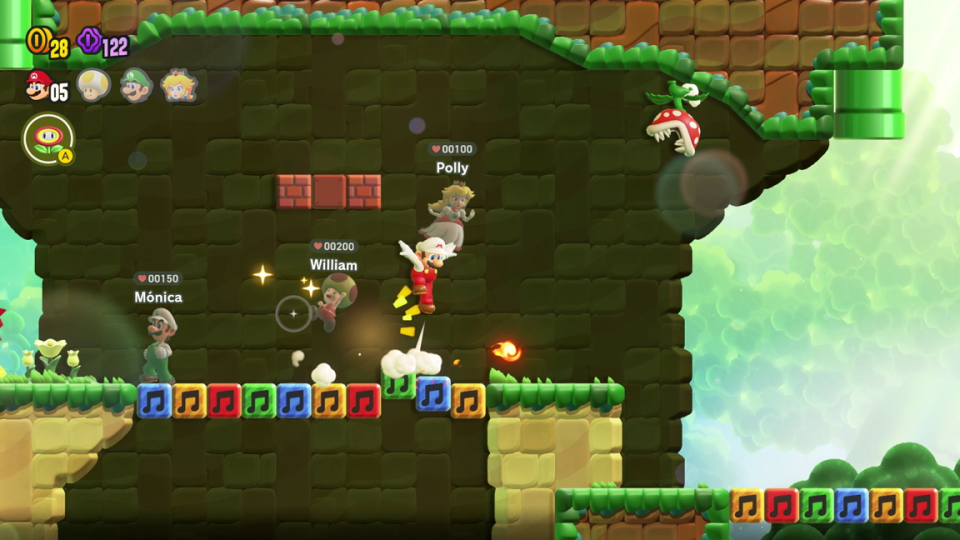
And all of this is essential, not just because local multiplayer is huge, but because the game introduces legitimate online co-op play for the first time. Players can opt to open their games up to anyone online to drop in, but in true Nintendo fashion, they’re pushing for a healthier style of play. Although you can play directly with friends and strangers, there’s also the option for online players to appear as transparent, ghostlike models who may not physically impact your game but may provide useful insight along the way.
Stuck in a particularly tricky jumping section? If your game is online, you may just see someone else swoop in and execute the jump on their own, giving you a hint. This works the same for finding hidden areas – why else would a stranger ghost be able to stand on an area where there’s no platform? This feeling was reinforced multiple times during our demo, as members of the press were all interlinked online and although we played at our own stations, we could readily see what others were doing on our own screen (and how we could do it better).
In a year filled with gaming revivals, it’s fitting that the final stretch is coming with an all-new Mario to cap it off. In many ways, it feels old in a new way. After 15-plus years of the New Super Mario Bros. style, Wonder feels like a breath of fresh air, even if it’s still at its core just a Mario game. If the full game delivers on the potential seen in the early stages, it promises to be lovingly crafted reinvention by a newly rejuvenated Mario team.
Super Mario Bros. Wonder launches for the Nintendo Switch on Oct. 20.
Best of Rolling Stone

